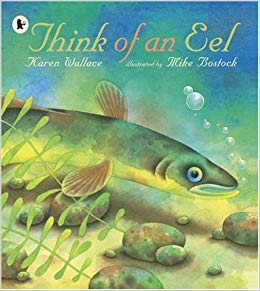 As part of the Professional Development of the LiS (Libraries in Schools) team, we were asked to prepare for a Book Talk on a book from the ‘Outstanding Shelf’. I was excited about this and asked for recommendations from the other team members. They suggested different books. Yet when I stood in front of the shelf, I was drawn to the book ‘Think of an Eel’, a book from the series of ‘Nature Storybooks’ written by Karen Wallace and illustrated by Mike Bostock.
As part of the Professional Development of the LiS (Libraries in Schools) team, we were asked to prepare for a Book Talk on a book from the ‘Outstanding Shelf’. I was excited about this and asked for recommendations from the other team members. They suggested different books. Yet when I stood in front of the shelf, I was drawn to the book ‘Think of an Eel’, a book from the series of ‘Nature Storybooks’ written by Karen Wallace and illustrated by Mike Bostock.
I looked at the cover page and liked the illustrations. Reading the blurb on the back cover, I felt that I would get more information about eels since I had read briefly about them in the book ‘Lakes and Rivers’ by Michael Chinery. After writing the book accession number on the library card, I wondered what I would read in it.
At home, when I started reading it I liked the book very much. The text was poetic and the illustrations complemented it well. The picture of an eel in my mind was formed as something colourful; its fish like features were emphasized. I liked every bit of information that I got from the book and felt sad to know what happens to the eel after it lays eggs. I remembered my trip to Besant Nagar beach in Chennai, where I saw many Olive Ridley turtles that had travelled miles to hatch their eggs. The eel too travels miles. They have an interesting life cycle where they change from ‘egg’ to ‘elver’ to ‘eel’.
The notes from the author and the illustrator given in its inner cover pages were interesting to read as well. The illustrator was reminded of myths about origin of eels that he had heard in his youth. This made me curious to know more about these myths, such as the one about eels forming from horse’s tails dipped in the river. I searched for more information about eels on Google and found out that an eel’s life had been a mystery for very long. Aristotle felt that eels came from earthworms while another scientist who tried studying about eels gave up after 4 years of research.

It was really a lovely read for me; when I shared it with my colleagues through a Book Talk, many of them were also interested in reading it. Perhaps you may like to read it too!
